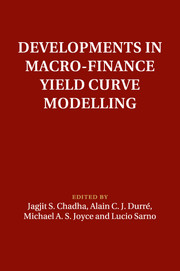Book contents
- Frontmatter
- Contents
- List of figures
- List of tables
- List of contributors
- Foreword
- Preface
- 1 Editors' introductory chapter and overview
- Part I Keynote addresses
- Part II New techniques
- 6 Compound autoregressive processes and defaultable bond pricing
- 7 Yield curve dimensionality when short rates are near the zero lower bound
- 8 The intelligible factor model: international comparison and stylized facts
- 9 Estimating the policy rule from money market rates when target rate changes are lumpy
- 10 Developing a practical yield curve model: an odyssey
- Part III Policy
- Part IV Estimating inflation risk
- Part V Default risk
- Index
7 - Yield curve dimensionality when short rates are near the zero lower bound
from Part II - New techniques
Published online by Cambridge University Press: 05 February 2014
- Frontmatter
- Contents
- List of figures
- List of tables
- List of contributors
- Foreword
- Preface
- 1 Editors' introductory chapter and overview
- Part I Keynote addresses
- Part II New techniques
- 6 Compound autoregressive processes and defaultable bond pricing
- 7 Yield curve dimensionality when short rates are near the zero lower bound
- 8 The intelligible factor model: international comparison and stylized facts
- 9 Estimating the policy rule from money market rates when target rate changes are lumpy
- 10 Developing a practical yield curve model: an odyssey
- Part III Policy
- Part IV Estimating inflation risk
- Part V Default risk
- Index
Summary
7.1 Introduction
The yield curve represents the relationship between the discount rates on a collection of default-free future cash flows, such as the coupon and redemption payments on UK government bonds, which differ only by their due date. By providing a spectrum of interest rates across future time horizons, the yield curve contains information regarding the whole market's expectations of future events, which is valuable for macroeconomic policymakers. In the UK government bond market, as in all bond markets, the cash flows to bondholders are made at regular but infrequent intervals. For a policymaker interested in a particular future date that does not happen to coincide with a cash flow date of a bond, there will be no directly observable discount rate. As a result, techniques have been developed to estimate the whole yield curve from the set of available bonds.
It is typical in bond markets for the set of future cash flow dates to far exceed the number of bonds, so giving rise to an under-identification problem when attempting to estimate the yield curve, as there are fewer known bond prices than unknown discount rates. The solution, first suggested by McCulloch (1971), is to approximate the yield curve with a low-dimensional function of maturity (the due date of the cash flow), which depends on a small number of parameters. By fixing a functional form for the yield curve, it also becomes possible to interpolate between observed maturities to obtain an estimate of the entire continuum of yields.
Information
- Type
- Chapter
- Information
- Developments in Macro-Finance Yield Curve Modelling , pp. 169 - 199Publisher: Cambridge University PressPrint publication year: 2014
Accessibility standard: Unknown
Why this information is here
This section outlines the accessibility features of this content - including support for screen readers, full keyboard navigation and high-contrast display options. This may not be relevant for you.Accessibility Information
- 1
- Cited by
